Noël Carroll’s concept of “art-horror” provides a comprehensive framework for understanding the intricacies of this genre. His three-step definition reveals the emotional and intellectual depths that art-horror can reach.
Firstly, art-horror elicits a potent emotional state, one that induces abnormal, physically palpable agitations.
Secondly, Carroll’s definition highlights the importance of the cognitive aspect, where beliefs, thoughts, and judgments about a specific class of objects play a pivotal role in generating the emotional response. Here, it’s essential to recognize the correlation between fear and anxiety. Horror often thrives on the viewer’s inability to predict or comprehend unfolding events, thus nurturing a sense of anxiety that amplifies the overall experience.
Finally, Carroll’s third step emphasizes that the art-horror object should possess both threatening and impure qualities, blending fear and disgust in his own words. This duality, in conjunction with the interplay of fear, anxiety, and the potential for static horror, results in a genre that engages the audience on numerous levels. In essence, art-horror becomes a multifaceted experience that challenges our emotional responses, intellectual faculties, and even our capacity to grapple with the unexpected, creating a rich and diverse landscape within the realm of artistic expression.
Expanding upon Carroll’s framework, it’s worth noting that, in some instances, the mere experience of disgust towards an object can be enough to qualify it as art-horror. This raises intriguing questions about the intersection of repulsion and fear, adding another layer of complexity to the genre. Moreover, it’s possible to create a compelling horror narrative without any overt movement or action from the horrifying object itself. The element of suspense, coupled with the viewer’s imagination, can be harnessed to create an atmosphere of dread and anticipation. In such cases, the object’s stillness can paradoxically intensify the horror, as the audience’s fear and anxiety build through anticipation and the unknown.
Author’s additional sentiments:
In the world of cinema, it’s hard to deny the immense potential of the horror genre. Unfortunately, many great film ideas often get tossed aside because the industry can sometimes steer in a different direction. But there’s good news too — thanks to advancements in technology, making movies is becoming less expensive.
One thing to remember is that we tend to think of horror as needing complex and expensive monsters or objects, like what Noël Carroll describes. These can indeed be impressive, but sometimes we overlook the power of simplicity. Horror can be created with much simpler elements and moments, and these can be just as effective in sending chills down our spines. So, while big, elaborate horror monsters have their place, let’s not forget the impact that simplicity can bring to the genre.
References:
Carroll, N. (1987). The Nature of Horror. The Journal of Aesthetics and Art Criticism, 46(1), 51–59. https://doi.org/10.2307/431308
